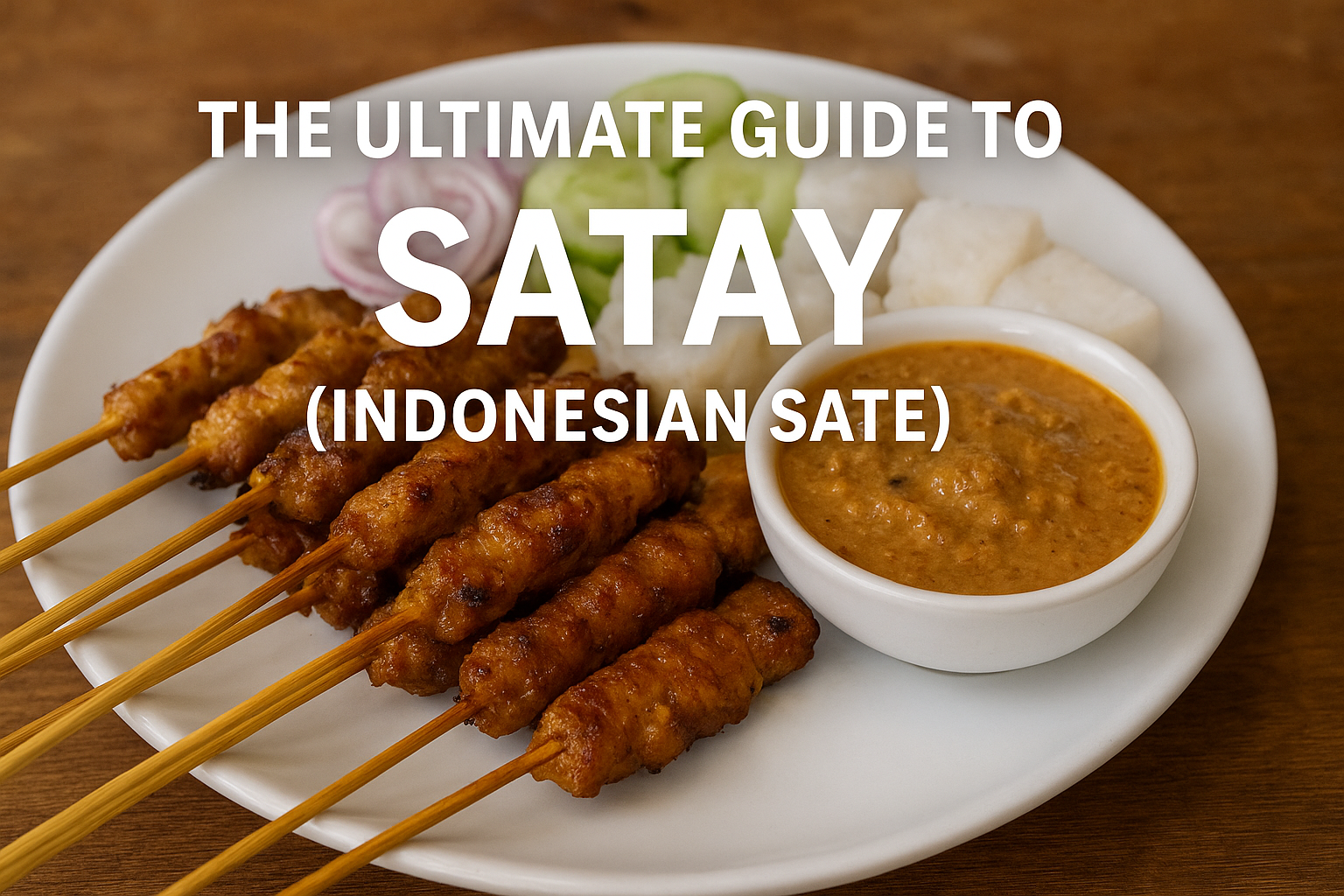Satay, or sate in Indonesian, is more than just grilled skewered meat—it is a cultural symbol, a culinary identity, and one of the most beloved street foods in Southeast Asia. Originating from Java, Indonesia, this simple yet flavorful dish has conquered not only the hearts of Indonesians but also food enthusiasts worldwide. Today, satay is recognized as one of the most iconic foods in Indonesian cuisine, often compared to sushi in Japan or pizza in Italy.
In this comprehensive guide, we will explore the history of satay, its variations across Indonesia and the world, cooking techniques, recipes, cultural significance, and why it deserves a spotlight in global gastronomy.
The Origins of Satay
A Culinary Heritage from Java
Satay is believed to have originated in Java, particularly in East and Central Java, during the early 19th century. Influenced by Middle Eastern kebabs introduced by Arab and Indian traders, locals adapted the idea of skewered meat and created their own version with Indonesian spices and flavors. Unlike kebabs, which often use lamb or beef exclusively, satay incorporates chicken, goat, fish, seafood, and even tofu.
Satay in the Colonial Era
During the Dutch colonial period, satay became increasingly popular across the archipelago. As Indonesia’s culture spread through migration, trade, and diaspora, satay traveled with it—becoming a favorite dish in Malaysia, Singapore, Thailand, and eventually the Netherlands.
Why Satay Became So Popular
- Affordable and Accessible – Skewers make it easy to portion and sell satay as street food.
- Variety of Flavors – Peanut sauce, sweet soy (kecap manis), and chili give satay a flexible taste profile.
- Portability – Satay is easy to grill and serve, making it perfect for street vendors.
- Cultural Versatility – Satay can be adapted for halal diets, vegetarian options, or modern fusion cuisine.
Types of Satay in Indonesia
Indonesia has more than 200 variations of satay, each with a unique taste. Here are the most famous:
1. Satay Madura
Perhaps the most popular type, Satay Madura uses chicken or goat meat served with thick peanut sauce, sweet soy, and fried shallots. Originating from Madura Island, it is sold across almost every corner of Indonesia.
2. Satay Padang
From West Sumatra, Satay Padang features beef, tongue, or offal with a thick, spicy, turmeric-based sauce. Unlike peanut sauce, its yellowish-brown gravy gives it a distinctive look and flavor.
3. Satay Lilit (Bali)
Satay Lilit is unique because minced fish, chicken, or pork is mixed with grated coconut and spices, then wrapped around bamboo sticks or lemongrass stalks. It’s fragrant and deeply tied to Balinese ceremonial traditions.
4. Satay Kambing (Goat Satay)
Popular during Islamic celebrations like Eid al-Adha, goat satay is marinated with soy sauce, garlic, and lime before grilling. The smoky aroma is a favorite among Indonesians.
5. Satay Maranggi
Originating from Purwakarta, West Java, this satay uses beef or lamb marinated in soy sauce, coriander, and spices, grilled without peanut sauce—served instead with sambal and pickles.
6. Satay Betawi
From Jakarta, Satay Betawi combines influences of Chinese, Arab, and native Indonesian cuisines. It often features beef or chicken with a combination of peanut and soy-based sauces.
Global Adaptations of Satay
Satay is not only loved in Indonesia but has gained recognition worldwide:
- Malaysia & Singapore: Satay here is almost identical to Satay Madura, often accompanied by cucumber, rice cakes (ketupat), and peanut sauce.
- Thailand: Thai satay uses more coconut milk in the marinade, creating a creamier taste.
- Netherlands: Due to colonial ties, satay became a staple in Dutch cuisine, often served with fries.
- Western Fusion: In Europe and the U.S., satay is often featured as an appetizer in Asian fusion restaurants.
How Satay is Made: The Cooking Process
1. The Marinade
Indonesian satay is marinated with spices like turmeric, coriander, garlic, shallots, lemongrass, and sweet soy sauce. The marinade ensures the meat is tender and flavorful.
2. Skewering
Traditionally, satay is skewered with thin bamboo sticks. This makes grilling easy and prevents meat from falling apart.
3. Grilling
Charcoal grilling is essential for authentic satay flavor. The smoke enhances the aroma and gives the meat a slightly caramelized edge.
4. Sauces
- Peanut Sauce: Creamy, nutty, and slightly sweet.
- Soy Sauce Mix: Sweet soy with chilies and shallots.
- Spicy Curry Sauce: Especially in Satay Padang.
Satay Recipes to Try at Home
Simple Chicken Satay Recipe
Ingredients:
- 500g chicken breast
- 3 cloves garlic
- 2 tbsp sweet soy sauce
- 1 tbsp lime juice
- 2 tbsp ground peanuts
- 1 tsp coriander powder
Steps:
- Cut chicken into cubes.
- Marinate with garlic, soy sauce, lime, and coriander for 2 hours.
- Skewer chicken and grill until cooked.
- Serve with peanut sauce and steamed rice cakes (lontong).
Cultural and Social Significance of Satay
Satay is more than food—it’s part of Indonesia’s cultural identity:
- Street Food Culture: Almost every Indonesian city has satay vendors at night markets.
- Festive Celebrations: Satay is served during weddings, Eid, and traditional ceremonies.
- Symbol of Unity: Despite regional differences, satay is a unifying dish loved by all Indonesians.
Health Aspects of Satay
While satay is delicious, it should be consumed wisely:
- High in Protein – Good for muscle health.
- Peanut Sauce Nutrients – Contains healthy fats and vitamins.
- Moderation Needed – Excessive consumption of fatty meat or sweet soy can lead to high cholesterol.
Satay in the Modern World
Today, satay continues to evolve:
- Fine Dining Adaptations: Satay is featured in Michelin-starred restaurants.
- Vegan Satay: Using tofu, tempeh, or seitan.
- Global Food Festivals: Satay represents Indonesian cuisine internationally.




